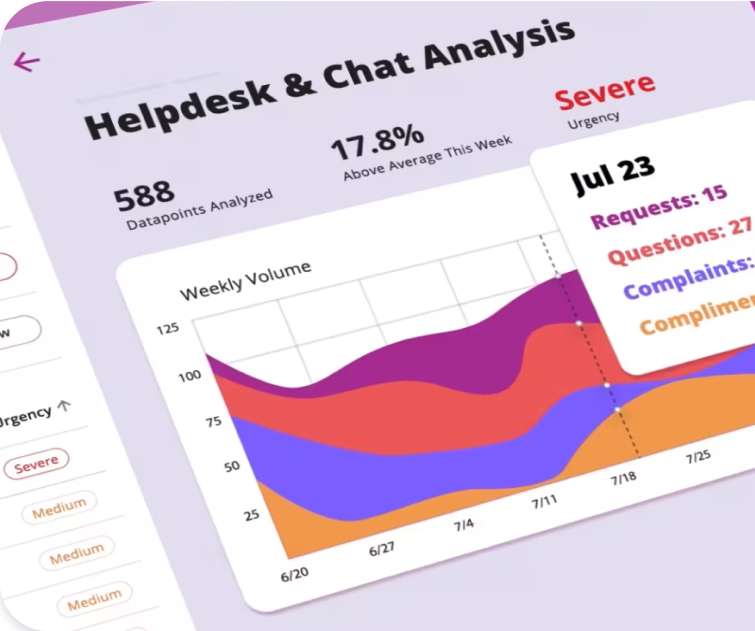
One of the fastest growing fields in business is user experience research. Why? Because more companies are developing a voice of the customer mentality to build products their customers will love and be willing to pay for in a heartbeat.
Below we break down the basics of user experience research and provide examples.
What is user experience research?
User experience research is the practice of understanding how users interact with products or services. It involves a set of tasks such as interviewing users about their use of a product or service, gathering their feedback via surveys or questionnaires, observing their interactions with a product, and connecting the dots between what they need and what they do.
What’s the value of user experience research?
User experience research helps researchers, product managers, customer support teams, designers, marketers, and anyone else in a customer-centric role develop products or services that are most likely to resonate with customers.
The needs of customers can shift constantly for a variety of reasons. Products or services may not meet customer needs consistently over time. Ongoing user experience research is important for helping businesses develop the best products and services to meet the changing needs of their customers.

Boost customer satisfaction with precise insights
Surface the most urgent topics by telling our AI what matters to you.
Types of user experience research
Most customer-led companies conduct both quantitative and qualitative user experience research. Quantitative research can tell you what users do, while qualitative research tells you why they do it.
Quantitative user experience research
Metrics that are measured in numbers—such as dollar volume, rate of growth, scores, number of users, amount of time users engage in a certain activity—fall under quantitative user experience research.
Quantitative user research tells you what a user of your product actually did or what they say they intend to do. The first is known as behavioral user research while the second is attitudinal user research. The number of landing page views is a behavioral research metric. The score from a survey question asking how often users expect to use your product in the next 6 months is an example of attitudinal research.
A few examples of data gathered for quantitative research include:
- Time spent on a website landing page
- Number of user sessions per week
- Monthly active users (MAU)
- Sign up conversion rate
- Survey questions with scores quantifying expected usage
- Customer lifetime value (LTV)
- Customer retention rate
Qualitative user experience research
You can find out why users took a particular action by conducting qualitative user experience research. This type of data is not measured with numbers. Qualitative data analysis requires different handling than its quantitative counterpart. (Viable saves companies a lot of time and cost by automating unstructured text analysis).
Some examples of qualitative research sources are:
- User interviews
- Social media engagements
- Free text feedback from in-app surveys
- Open-ended answers in CSAT or NPS surveys
- Usability testing sessions
- Focus groups
- Ethnographic studies (at a user’s home or work environment)
There are other types of research that assess things other than the user experience, such as product concepts, a business hypothesis, or brand awareness.
How to start doing UX research to inform your strategy
Knowing how to conduct user interviews and doing them on an ongoing basis is the best way to step into their shoes. In fact, qualitative data analysis on a continuous cadence should help you identify rich insights for your product roadmap.
As builders, we are often too close to our own work to understand how users are actually experiencing our products. Doing user experience research regularly, analyzing the data, and using the insights to inform your product development process is what feedback loops are all about.
Some ways you can gather user experience data include:
- User interviews with current customers
- Digital experience tools (like Fullstory) that capture user interactions with your product
- User flow analytics that capture the user journey (like Mixpanel)
In lieu of interviewing customers—or to add a different perspective—you can find prospective users willing to give you feedback via:
- Industry associations
- Slack communities
- Introductions from your network, including LinkedIn
- Facebook groups
- Market research agencies (if you’ve got the budget)
How to do user interviews
A lot of great content exists on how to apply insights from customers to the product development process. Getting familiar with the concept, methods, and tools for staying organized is a great first step.
Specifically, you may want further guidance on how to conduct user interviews. A practical resource with step by step instructions and templates is the book Lean Customer Development, by Cindy Alvarez, an expert in the customer research and user experience field. She built her career at top startups and then brought an agile, user research culture to Microsoft with much success. For any builders at any stage of product development, we recommend reading Lean Customer Development.
However you choose to start, recognize that it’s a process that will evolve and you’ll get better at it. Gathering and making use of user experience feedback eventually becomes second nature.
Viable can save you a lot of time in qualitative data analysis
Once you’ve got user feedback data consistently coming in, getting useful insights from it is the next step. With automated aggregation, tagging, and analysis, Viable saves you time so you can more quickly identify what customers want, increase retention, and grow your business.
Connect with us
%20(10).png)
%20(9).png)
%20(8).png)
